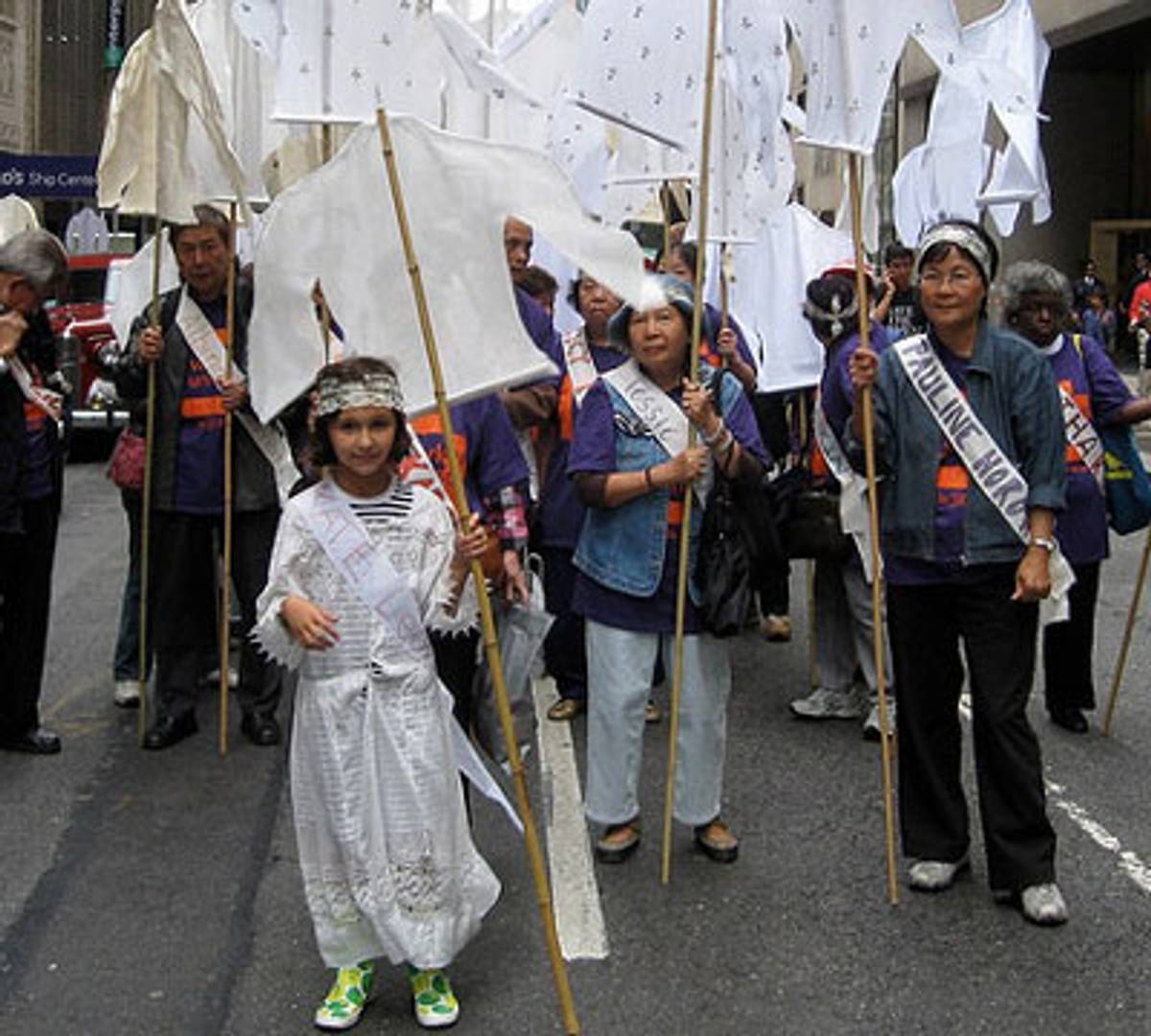Teaching Kids About Labor Day
The best children’s books about the labor movement—and the part Jews have played in it




It’s ironic that a holiday established to celebrate American workers has become one of the longest, most difficult workdays for retail employees.
So, instead of hitting the sales and adding to modern-day workers’ burdens, why not focus on family time and rest—the original point of this holiday, after all—and talk to your kids about the why Labor Day is important?

If you’re a regular Tablet reader, you probably know about my own obsession with labor issues. My daughter Josie (now 13) and I have long been particularly fascinated by the Triangle Factory Fire, which claimed the life of 146 people—most of them young Jewish women—in a garment factory in 1911. This disaster, which occurred close to where we now live in New York’s East Village, helped lead to safer workplaces and better child labor laws. Every year on the March 25 anniversary of the fire, Josie and I participate in CHALK, a public art project in which we write the names of victims in chalk in front of the tenements where they once lived. When Josie was 7, she got to march in the New York City Labor Day Parade, under the auspices of the Remember the Triangle Fire coalition. She fell in with a group of older Chinese women protesting sweatshop conditions, but abandoned them mid-parade when a fireman offered to let her ride in his truck. (I mentioned that she was 7, right?)
Why is it important to discuss Labor Day with kids, even though many adults don’t think about why it exists, and not everyone gets to spend it in a fire truck?
“Even young children can benefit from a lesson about the power of collective action and organization in achieving results that individuals working alone may not be able to accomplish,” explained Professor Yana V. Rodgers, director of Rutgers University Project on Economics and Children, in an email interview.
One of the best introductions to the notion of working together toward a common goal is the now-classic children’s picture book Click Clack Moo: Cows That Type, by Doreen Cronin, illustrated by Betsy Lewin. It’s hilarious, but also pointed. The cows get hold of a typewriter and inform Farmer Brown that the barn gets really cold at night, so they’d like some electric blankets. Farmer Brown refuses. The cows, in return, refuse to give him milk. Then the hens write that they’re cold, too, and refuse to give Farmer Brown eggs. Will Farmer Brown give them all blankets? (What do you think?) Kids love the book and immediately understand that the animals have more power when they band together. They also get that what the animals want is reasonable—no one likes to feel chilly! If you’re one of those people who thinks unions are destroying America, you’ll get a kick out of Duck’s final demand that the farm’s pond needs a diving board. It’s funny, but also a fine jumping-off-point (ha, I slay myself) for a parent-kid discussion about which requests are reasonable and what business owners owe their workers.
In addition to Click Clack Moo, check out Brave Girl: Clara and the Shirtwaist Makers’ Strike of 1909, by Michelle Markel, illustrated by Melissa Sweet. I adore this 2013 charmer, which was on my Best Jewish Children’s Books of the Year list. It’s the true story of Clara Lemlich, a tiny teenage girl who helped make workplaces safer for all her fellow factory workers. She was beaten by cops and regularly hauled into jail, but she kept fighting for justice. The mixed-media illustrations are delightful, incorporating swatches of fabric, snippets of timecards and ledgers, and lots of stitched thread. The book concludes:
Her throat is hoarse, her feet are sore,
but she has helped thousands of people.
Proving that in America,
wrongs can be righted,
warriors can wear skirts and blouses,
and the bravest hearts
may beat in girls
only five feet tall.
Aaaaaand … I’m crying again.
Other picture books you should check out include Migrant, by Maxine Trottier, illustrated by Isabelle Arsenault (about a family of Mennonite farm workers from Mexico and their little girl who just wants to stay in one place instead of constantly having to travel to follow the harvest); Harvesting Hope: The Story of Cesar Chavez, by Kathleen Krull, illustrated by Yuyi Morales (about the activist who led a huge march and nonviolent protests to help his fellow farm workers); and Tomás and the Library Lady, by Pat Mora, illustrated with luminous scratchboard paintings by the great Raúl Colón (the true story of a son of migrant workers who grew up to be a chancellor at the University of California with the help of a non-Spanish-speaking librarian who helped him discover the joys of books when he was little).
If your kids are older and reading independently, give ’em Fire at the Triangle Factory, by Holly Littlefield, the book that turned Josie on to the history of the Triangle Fire and labor movement when she was in first or second grade. It’s an easy reader about two 14-year-old friends, one Jewish and one Italian, who escape the terrifying fire together. The focus is on their friendship, and it’s not too terrifying for little kids, while also making clear why unsafe working conditions caused terrible loss of life. Another book that Josie loved as a second-grader was Rosie in New York City: Gotcha!, part of a series of books about a spunky 11-year-old who witnesses big events in history in New York City, then Chicago, then Los Angeles. In this installment, she takes over her mother’s job in a garment factory when her mom gets sick and has to deal with terrible conditions (the girls aren’t even allowed to hum at their stations) and winds up getting involved with strikers against her father’s wishes. Again, the book isn’t too depressing or upsetting, and it gives you an in to talking about Jews in the labor movement, and how lucky your kids are to go to school instead of working in the fields or a factory. (They may not believe this at this time of year.)
Finally, believe it or not, the Harry Potter books have their own labor story: that of Dobby, the House Elf. There’s a subplot in the books, though not in the movies, about Hermione wanting to help free the house-elves. House-elves are goblin-like indentured servants for rich wizards, and they can be liberated only if a master hands them a sock. (Hey, Muggle, don’t question the ways of the wizarding world.) Parents can talk to kids about how unfair it is that house-elves aren’t paid and don’t get time off, and how Ron and Harry are initially dismissive of Hermione’s activism and mocking of the house-elves (whom they think are ugly) but gradually become sensitized as they get to know Dobby.
If you have a teenager at home, he or she has probably already read the Hunger Games trilogy or seen the movies, because this series is a teen obligation of today, much like sulking and eye-rolling. It also has lessons about labor. The series takes place after a failed revolution, in which oppressed districts tried to overthrow the oligarchic Capitol. As the action starts, the districts have been beaten down, and the Capitol profits from their work—District 4’s industry is fishing, District 7’s is lumber, District 12’s is coal, etc.—without giving them a fair share in the proceeds. The annual games, in which teenagers from all the districts battle to the death, are presented as a distraction, a vast stadium-set entertainment designed to keep people staring at screens and distracted from the inequities in their lives. The Capitol provides manufactured love stories and contestant profiles, all calculated to stir up jingoistic local cheerleading while keeping the focus off the Capitol’s wealth and decadence.
If your teen will deign to talk to you, read the books yourself (they’re really good!) and use them as a jumping-off point for conversations about societal inequities, amusing ourselves to distraction, and the power of cross-community and cross-cultural alliances to change history. (When the heroine Katniss forges a genuine human connection with Rue, a girl of another color from another district, she sets in motion a series of changes that ultimately brings down the Capitol.)
Or hey, as a family, you could watch the Disney musical Newsies (marvel at the adorablity of teen Christian Bale!), about the 1899 newsboy strike in New York City, or The Pajama Game, a 1950s musical about union activity in a pajama factory. Coo at the union leader and a factory superintendent who fall in love, frolic vicariously at the festive company picnic, slink about the kitchen to “Hernando’s Hideaway,” and cheer on the workers seeking a seven-and-a-half cents an hour raise!
Seven and a half cents doesn’t buy a hell of a lot,
Seven and a half cents doesn’t mean a thing!
But give it to me every hour,
Forty hours every week,
And that’s enough for me to be living like a king!
Only five years from today!
Five years!
Let’s see…that’s 260 weeks times 40 hours every week
And roughly two and a quarter hours overtime
At time and a half for overtime
Comes to exactly… $852.74!
That’s enough for me to get
An automatic washing machine,
A year’s supply of gasoline,
Carpeting for the living room,
A vacuum instead of a blasted broom,
Not to mention a 40-inch television set!
Look, no matter how old your kid is, you can explain Labor Day in a sentence: Back in the late 1800s, many Americans had to work 12 hours a day, seven days a week—kids, too!—in unsafe conditions, without enough bathroom breaks, until groups of workers banded together in unions and helped advocate for better conditions. Feel free to add that Jews were a huge part of this movement, and as part of our ongoing efforts at tikkun olam (fixing the world), we should continue to advocate for workers still being exploited in America (holla, Walmart!, hey there, Amazon!) and in other countries.
There you go. Amen.
Correction: My daughter informs me that I’ve made a Harry Potter error: You have to give a house elf an item of clothing (not necessarily a sock) to free him or her.
Marjorie Ingall is a former columnist for Tablet, the author of Mamaleh Knows Best, and a frequent contributor to the New York Times Book Review.